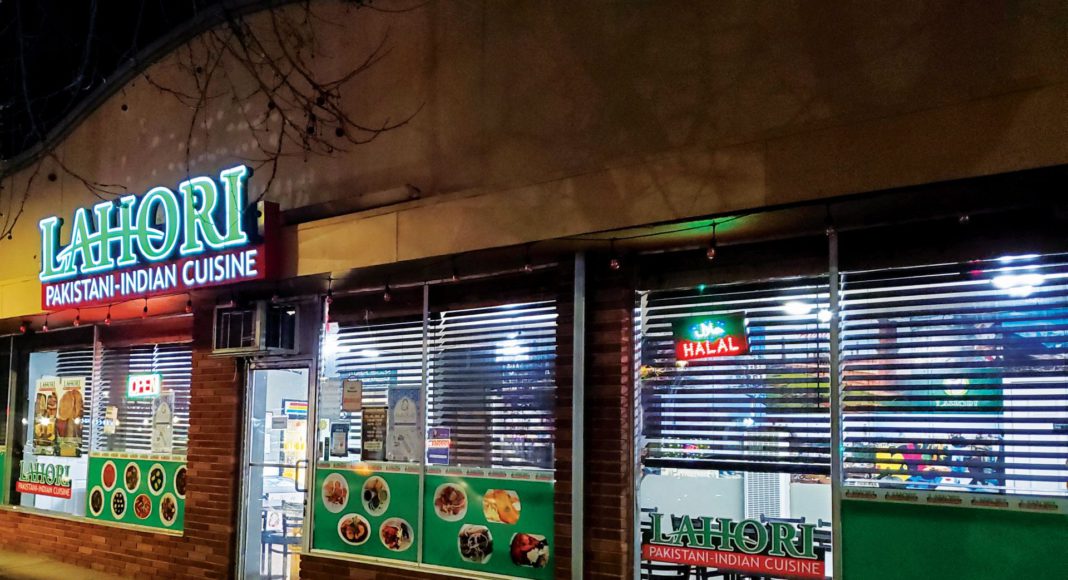With a belly full of Punjabi food, I walked past Mexican quinceañera dresses to raise the ghosts of theaters past. My journey began at Lahori Restaurant on East Santa Clara Street, where a plate of aloo palak, a circular slab of garlic naan and too much chai perfectly fueled my spacetime-shattering survey of the landscape.
Outside, the neighborhood was just as I remembered. Beautifully incongruous buildings, heroic in their janky faded elegance, highlighted the scene. Bulky apartment houses rose from behind single-story retail shops. There were salons and restaurants, all fluently bilingual. The Mi Carnaval Party Supply shop was still there, but Plaza Garibaldi was not.
Standing out on a dark rainy night, the green lights of the Lahori signage burst through the drab grayness of the horizon. Green was the color of Pakistan, of course, and Lahore was the ancient cosmopolitan former capital of Punjab, a city no longer a part of India, as of 1947.
Inside Lahori, the restaurant, I was transplanted to the old country. On one wall, I saw a poster of Faisal Masjid, the famous mosque in Islamabad, right above a poster of Muhammed Ali Jinnah, the founding politician of Pakistan. Imagery of colorful hand-painted rickshaws covered the rest of the wall, along with food and more religious structures. On another wall, right above the self-service chai dispenser, I found a poster of the Kaaba in Mecca.
Lahori was a peaceful eatery. As I plowed through my aloo palak, the bearded proprietor grabbed the remote, pointed it to the TV across the restaurant, and there appeared a travel video through the bustling bazaars and frenzied streets of old Lahore, including numerous food vendors and a restoration project at the Wazir Khan Mosque.
Sitting in the restaurant surrounded by such gorgeous reflections of an ancient place, I was reminded of a story Farhan Ahmed Shah penned in the Express Tribune over a decade ago, “Legends of Lahore,” in which he wrote: “Lahore has been mercilessly plundered, torched and razed to the ground several times. But no matter how many times it has been destroyed, this city of mine has always risen Phoenix-like from the ashes—stronger than ever before.”
Continuing, Shah lauded Lahore’s survival. After seeing ages of war and devastation, it was a city of vivid differences and haunting nuances where vastly different epochs of architecture might all appear on the same block of the street.
“For those who know how to listen, every place in Lahore—from the most monumental structure to the most ordinary street—has a story to tell,” he wrote.
Moments later, I felt those exact words as I shuffled across the street to the old Mexico Theater, a nostalgic building for many, many people in this part of San Jose. The front of the complex has now been converted into Celia’s Boutique, a place that sells vibrant quinceañera dresses. The green signage of Lahori, plus the bright yellow and red shades of the huge dresses displayed in the entryway exploded against the drab, rain-soaked skyline, especially as the nighttime darkness descended.
The Mexico Theater building had a long history—long for San Jose, at least—and it was mentioned in at least two books. The building opened in 1949 as the Mayfair Theatre, then later became the Esquire Theatre before converting yet again to the Mexico Theatre, in the early ’80s, after which Steve Wozniak even spent a pile of money to restore the place, but it sadly never returned to its former glory. Since it closed 20 years ago, the theater has been one of San Jose’s most favorite faded landmarks, with multiple generations perpetually scrambling to prevent its destruction.
As I walked up, a faded poster from the 1962 film “Marco Polo” starring Rory Calhoun graced the front of the building. The quinceañera dresses were on full display. The neon MEXICO lights on the cylindrical Streamline Moderne style tower were aglow, as was the backlit glass in the entryway. All of which improved the darkness.
That was it. My journey was complete.
Only in the glorious environs of East San Jose would Punjabi food and quinceañera dresses rescue me from the noir, rain-soaked misery of winter. Marco Polo would have been proud.



